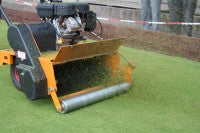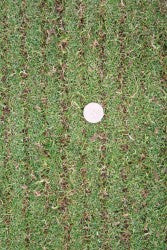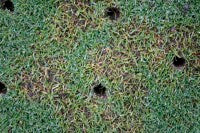Caring for Bowling Greens Through the Autumn / Winter Period
 The Autumn is the most critical period of the year for the bowling green after all the wear and tear of the busy playing season.
The Autumn is the most critical period of the year for the bowling green after all the wear and tear of the busy playing season.
The treatments performed at this time dictate the performance of the green the following season. No concerted effort in the Spring will correct any deficiencies you may not have undertaken in the Autumn. Proper attention in the Autumn will ensure the green will be in first class condition for the following year.
Immediately the green is closed, the first major operation with regards to the renovation programme is scarification and thatch control, the removal of organic matter from the immediate surface of the green.
 A Sisis root rake or the more aggressive Graden have proven most effective at removing dead grasses and excess fibre. During the work the blades should be kept clean and free from clogging debris so that penetration is not impeded. All arisings should be cleaned from the surface prior to the next treatment, that of aeration.
A Sisis root rake or the more aggressive Graden have proven most effective at removing dead grasses and excess fibre. During the work the blades should be kept clean and free from clogging debris so that penetration is not impeded. All arisings should be cleaned from the surface prior to the next treatment, that of aeration.
The industry has numerous mechanical apparatus capable of surface to sub surface aeration from surface piercing, e.g. Sarel Roller, to the deep aeration equipment capable of over 200mm.
However, solid or chisel tines should be continued through the Autumn / Winter period at regular intervals. Whenever the ground and climatical conditions permit, aeration must be encouraged.
Regular drag brushing is also a good practice to help disperse dew and help to raise prostrate stems and leaves for the mower blades to do a better job and prevent the spread of disease.
Another important phase of the work in the Autumn is to top dress the whole area using a recommended mixture of sand and eco. The zeolite natural, volcanic, organic material has been found to greatly assist in the quality of the top dressing. It also provides nutrition and soil conditioning within the soil profile, but does not impede the percolation rate at which the green drains excess water.
Spread the top dressing mixture at 5Kg per square metre. The material should be evenly applied so that it does not smother the turf.
Spreaders, e.g. the Sisis true spreader, is ideal for small areas such as the bowling green, particularly if there is a restriction on entry to the green. If there is little problem in this regard, then a Pro seed or similar unit is quicker and more effective, e.g. a seeding hopper enables the greens to be overseeded while top dressing, followed by the brush attachment, thereby the top dressing is brushed well into the crown of the grasses and the linear lines produced from the scarification operation. Continue to brush regularly following the top dressing to aid further infiltration.
Bowling green levels are often a source of concern and low spots can be raised by repeated little and often light application of top dressing. A cord, drawn tight across the surface, will show up the sunken spots which should be marked out and treated with the approved top dressing material. The development of the true lute makes it the ideal implement for this job as the cutting edge and the reversal double edge grid push the top dressing into these low areas, thus forming a surface level which is true and smooth.
 High spots within the green can be gradually lowered by hollow tining, watering and light rolling to press the soils down. This is slow and difficult, but achievable if patience is your virtue. The holes set at 50x50x50x50mm are best suited. The cores should be swept up when the work has finished. This treatment may have to be repeated at reasonable intervals until the correct level has been achieved.
High spots within the green can be gradually lowered by hollow tining, watering and light rolling to press the soils down. This is slow and difficult, but achievable if patience is your virtue. The holes set at 50x50x50x50mm are best suited. The cores should be swept up when the work has finished. This treatment may have to be repeated at reasonable intervals until the correct level has been achieved.
Very few bowling clubs have spare ground to produce a small turf nursery whereby turf of a similar species and quality may be grown for the replacement to any damaged or worn areas within the green. It is very important for such areas to undergo remediation and repair. Over a period to time surface damage and levels drop along the edges of the green. Always overlooked, these edges should be corrected by cutting the turf and rolling it back far enough to enable you to pack the soil with additional top dressing mixture, sufficient to restore a true level.
I have seen, all too often, patching of greens with poor grasses, often Yorkshire Fig, not conducive with quality grass species. Furthermore, any turf used to repair bare patches should be laid flush with the existing ground levels. If the turf sticks proud of the surface it will be shaven by the mower, resulting in damage to the turf.
Great care should be taken not to allow the turf to dry out, even in the Autumn drying winds, which tend to stress the newly laid turf. Prior to any turfing, the addition of humates in the top dressing ensures quick and effective rooting to the existing profile.
Light tamping of the turf will assist in the rooting of the new turf. Do not over roll as this will only damage the roots, thus restricting anchorage and plant development. Ensure there are no air pockets between the roots of the new turf and the soil bed, otherwise, drying out may be caused and the turf will likely die off.
For the Winter work, use the drag brush from time to time, particularly when the grass leaf blades are covered with moisture. The dissipation of dew will reduce disease ingress while invigorating the sward.
Give the green a trim with the mower set at 10mm whenever possible. I have found a rotary mower with very sharp blades not only trims the grasses, but due to the down force of the blades, helps to dry out the grasses while picking up any leaves or other debris which is lying on the green.
Continue aeration with chisel tines when weather is conducive. At least once per month through to March has proven benefits to the health of the grasses while improving decompaction and drainage.
 Always be vigilant for any sign of disease and treat immediately as not doing so will only lead to disappointment and long term scars in the Spring of the forthcoming season.
Always be vigilant for any sign of disease and treat immediately as not doing so will only lead to disappointment and long term scars in the Spring of the forthcoming season.
I believe that nutrition throughout the Winter will bring about healthy plants which are less prone to attack from disease. Furthermore, by regular input of liquid nutrition and soil conditioning will aid the plants as they come out of their dormancy in Spring.
Salt based fertilisers are not encouraged, but calcium, magnesium and chelate iron in a balance of amine nitrogen are proven to be of great value.
Earth-Tec Ltd have a new scienced produced known as EarthDefence which reduces fungicidal application while satisfying the need of the plant and, due to the natural blend of nutrients, suspends the likelihood of disease. It acts a bit like a flu vaccine, you may get a snotty cold, but should not get the flu.
David H. Bates has over 35 years in the management of turf and trusts you will deem these points helpful and constructive.
DAVID H. BATES AGRONOMY SERVICES LTD
Independent Agronomy and Environmental Services
For further information contact David at DHBatesservices@aol.com
